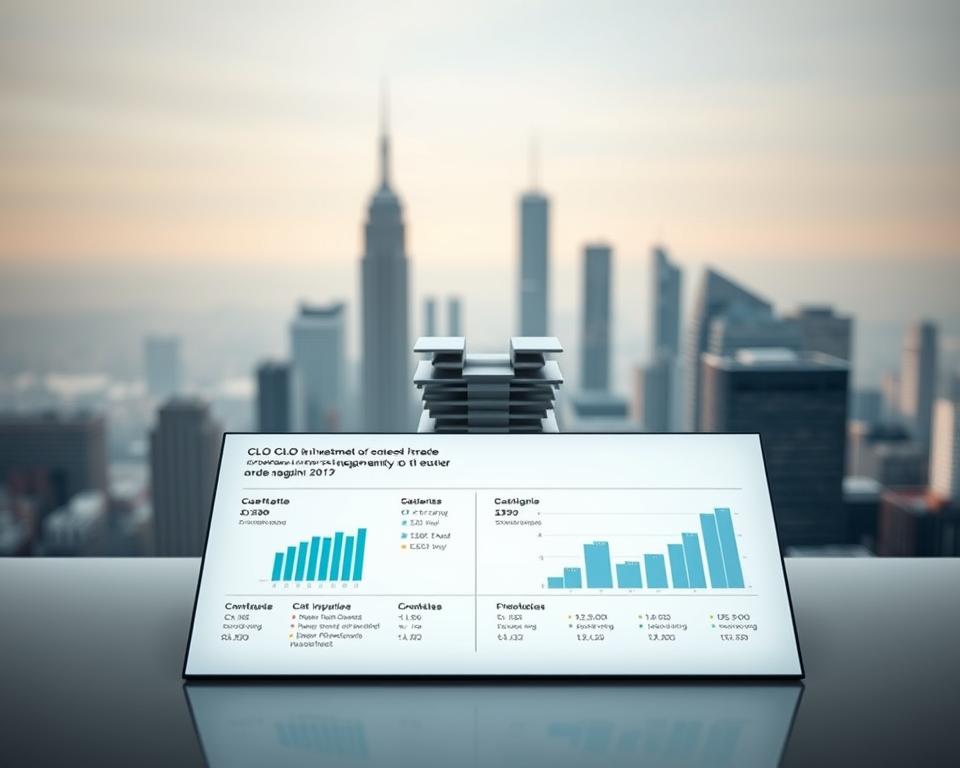
How to Monitor CLO Equity Fund Health Over Time
A Guide to Investing in CLO Equity Funds: Essential Insights
The collateralized loan obligation (CLO) market has grown significantly over the past 35 years, evolving into a $1.1 trillion pillar of corporate financing, with US BSL CLOs accounting for about 68% of demand for US corporate loans.
CLO equity captures the difference between loan interest earned and debt owed to CLO debtholders, offering a unique investment opportunity with potential double-digit returns. This asset CLO equity performance class combines the benefits of private equity with bond-like cash flows.
Main Points

- CLO equity represents a high-risk, high-reward tranche within the $1.1 trillion CLO market.
- Investors can benefit from double-digit returns with quarterly distributed cash flows.
- Understanding CLO equity is crucial for evaluating its place in a diversified portfolio.
- The performance drivers of CLO equity contrast sharply with those of standard fixed-income or equity assets.
- It’s essential for investors to assess the risks and benefits before investing.
CLO Equity Fundamentals
Understanding CLO equity starts with knowing how Collateralized Loan Obligations (CLOs) are structured. A CLO functions like a corporate entity, raising capital to acquire a diversified pool of leveraged loans. Typically, it invests in between 150 and 350 leveraged loans that act as security for the CLO.
Defining Collateralized Loan Obligations
Collateralized Loan Obligations (CLOs) are structured credit instruments that pool together a diverse collection of leveraged loans, creating a securitized investment vehicle with multiple tranches of varying risk and return profiles. Such a layered structure provides a menu of risk/return slices for various investor appetites.
Equity Tranches Explained
Sitting at the base of the capital stack, the equity slice is vital to a CLO’s design. It sits at the bottom, making it the first to absorb losses but also the first to benefit from excess returns generated by the underlying loan portfolio. Thus, equity investors bear the lion’s share of credit risk but can reap outsized rewards.
How CLO Equity Generates Returns
CLO equity generates returns through the spread between the interest received from the underlying loan portfolio and the interest paid to CLO debt holders. This creates a leveraged exposure to corporate credit, making CLO equity an attractive option for investors seeking higher yields. Recognizing that both assets and liabilities reset periodically is key to forecasting CLO equity outcomes under shifting rate regimes.
The Structure of CLO Equity Funds
To diversify effectively, investors must know how CLO equity funds are built. Such funds pool capital to buy exposure to the equity slices of multiple CLOs.
CLO Funding Stack and Waterfall Payments
CLOs use a tiered waterfall to allocate cash precisely. It dictates the order of expense coverage, debt servicing, and equity distributions. Only once fees and senior debt are paid does the leftover spread flow to equity holders. The cash flow from a CLO runs through a quarterly payment waterfall, ensuring that equity investors receive distributions only after all senior obligations have been satisfied.
- The CLO funding stack places equity at the bottom of the capital structure, creating a 10:1 leverage ratio that amplifies both potential returns and risks for equity investors.
- Debt tranches gain protection via overcollateralization buffers and coverage tests.
Equity Tranche Position and Risk Profile
As the most junior, equityholders absorb loan defaults before any debt tranche is affected. Yet in strong credit markets, equityholders enjoy the lion’s share of excess returns. CLO equity funds typically hold positions in multiple CLO equity tranches, providing diversification across different CLO managers, vintages, and underlying loan portfolios to mitigate concentration risk.
Understanding the structural protections and constraints within CLOs is essential for equity investors, as these features influence both the timing and magnitude of distributions throughout the investment lifecycle.
Why Invest in CLO Equity Funds?
CLO equity investments have gained popularity due to their potential for generating substantial returns through quarterly distributions. This investment vehicle offers a unique combination of attractive returns, front-loaded cash flows, and diversification benefits, making it an appealing option for investors seeking to enhance their portfolios.
Attractive Return Potential
CLO equity funds offer investors the potential for double-digit annual returns, delivered through quarterly distributions. This creates an attractive time-weighted return profile compared to other alternative investments. Historically, the CLO equity segment has delivered robust results for yield-seeking investors.
Front-Loaded Cash Flows
Unlike private equity’s J-curve, CLO equity delivers cash early on. This provides investors with earlier access to returns and reduces the weighted average life of the investment, making it a more attractive option for those seeking liquidity.
Portfolio Diversification Benefits
CLO equity adds diversification value to a broader portfolio. The asset class has historically exhibited low correlation with traditional asset classes, with correlation coefficients below 50% even with adjacent fixed income sectors like high-yield bonds. This makes CLO equity an excellent addition to a diversified investment portfolio.
Key Risks Associated with CLO Equity Investments
Recognizing CLO equity’s risk profile is vital for prudent portfolio diversification. They carry distinctive hazards that must be weighed alongside their upside potential.
Credit and Default Risks
CLO equity holders face pronounced credit risk. Loan defaults hit equity returns first, given its subordinate position. The equity tranche, being the most junior, absorbs the initial losses, making credit risk management critical.
- Equity returns feel the immediate impact of defaults.
- Losses funnel first to the equity layer.
- Robust credit risk controls are vital to limit downside.
Volatility Considerations
Price swings can sharply move CLO equity valuations. Although the term financing structure of CLOs prevents forced selling during market dislocations, potentially limiting permanent capital impairment, investors must still contend with valuation fluctuations.
Liquidity Risks
CLO equity liquidity merits careful review. Stress periods may choke secondary trading, hampering exits. Investors must factor in these liquidity dynamics when sizing positions.
- Trading desks may thin out under stress.
- Limited exit opportunities can affect investor liquidity.
- Proper risk management includes considering liquidity risks.
In conclusion, while CLO equity investments offer attractive returns, they are accompanied by significant risks, including credit risk, market volatility, and liquidity concerns. Investors must carefully evaluate these risks and consider strategies for mitigation.
How Active Management Creates Value in CLO Equity
Effective active management is a key driver of value creation in CLO equity. Ongoing surveillance and tactical adjustments by adept managers can boost equity returns markedly.
The Reinvestment Period Advantage
In the 4–5 year reinvestment window, managers can trade up holdings to capture fresh value. Active management during this period is crucial for maximizing the benefits of CLO equity investments.
Discount-to-Par Tactics
Par building involves purchasing loans at discounts to par value, which can create substantial value for equity investors due to the leveraged nature of the CLO structure. A discount of 2% can translate to a 20% benefit for equity investors, highlighting the importance of strategic trading decisions during the reinvestment period.
Debt Optimization Techniques
Refinancing and reset options provide CLO equity investors with additional tools to enhance returns. By reducing debt costs or extending the reinvestment period, investors can take advantage of favorable market conditions, further optimizing their investment strategy.
Active management represents a critical value driver for CLO equity investments. Through savvy trades, discount capture, and debt reengineering, managers can unlock material investor value.
Comparing CLO Equity to Other Alts
CLO equity’s unique blend of yield, liquidity, and risk differentiates it among alts. Investors weighing alts should map how CLO equity stacks up on return, duration, and liquidity.
CLO Equity vs. Private Equity
Unlike private equity’s long hold and J-curve, CLO equity delivers early, regular cash. CLO equity starts paying out within roughly half a year, shunning the typical PE J-curve. This results in a shorter investment duration, typically ranging from 3-5 years, compared to the 7-10 years associated with private equity. Additionally, CLO equity offers more predictable cash flows and greater liquidity, although it may yield lower total returns in strong market environments.
During reinvestment phases, annualized equity cash-on-cash returns have often hit the mid- to high-teens. That, along with a briefer time horizon, positions it well for investors wanting speedier payback.
Comparison with Fixed Income and Credit Investments
Versus plain-vanilla credit, CLO equity can hand out much greater yields—but with amplified risk and liquidity trade-offs. Its variable-rate structure often cushions equity when rates climb, relative to fixed-rate debt. Investors must weigh these factors when determining the appropriate allocation to CLO equity within their diversified portfolio of alternative investments.
CLO Equity Through the Cycles
Some investors mistakenly believe CLO equity’s best days are behind it. Yet, it has shown strong resilience and counterintuitive returns in various cycles.
Economic Downturns and CLO Equity
Equity prices may wobble in recessions. But the financing terms avert fire-sales, giving managers a chance to buy loans on the cheap and boost longer-run yields. Indeed, vintages launched before stress events—like pre-2007—often captured deep discounts in their reinvestment windows.
Rate Regime Impacts
In rising rate environments, CLO equity benefits from the floating-rate nature of both its assets and liabilities. Its net sensitivity hinges on how much more assets reset than debt. Knowing this guides savvy investors on how to stagger vintages for smoother performance.
Its adaptability across regimes cements its role as a compelling diversifier. Performance drivers include manager prowess and the built-in leverage and credit protections of the structure.
How to Invest in CLO Equity Funds
Investors seeking to tap into CLO equity funds have multiple avenues to consider, each with its unique advantages and considerations.
Direct Deal-by-Deal Investments
Picking individual CLO equity tranches deal by deal grants the most control. You can select managers and deal structures tailored to your goals. But it demands deep credit analysis capabilities and operational bandwidth.
Captive Fund Structures
Captive funds pool capital to buy broad CLO equity baskets. A seasoned manager then navigates vintages and credit selection on behalf of the fund. It lowers the entry barrier and dampens single-vintage swings via built-in diversification.
Credit Fund Alternatives
Multi-asset or opportunistic credit funds offer a simplified way to gain exposure to CLO equity as part of a broader credit investment portfolio. While this approach dilutes the specific benefits of CLO equity, it provides a diversified credit portfolio managed by professionals. Review objectives and cost structures closely before committing.
The choice among these options depends on an investor’s size, sophistication, resources, and investment objectives. Larger institutional investors often prefer direct investments, while smaller investors may benefit from fund structures that offer diversification and professional management.
Manager Selection: Critical Factors for Success
Your CLO equity outcome largely rests on manager caliber. A manager’s portfolio design, research depth, and trade execution shape final equity yields.
Proven Performance
A manager’s track record and experience are crucial in determining their ability to navigate various market cycles. Investors typically seek managers who have demonstrated consistent performance across multiple CLO vintages.
Philosophy & Risk Controls
Managers differ in how they balance distribution yield versus capital preservation. Some chase high current payouts; others emphasize downside protection and long-term gains. Evaluating a manager’s credit research capabilities and approach to managing deteriorating credits is essential.
Align their risk framework with your own return and volatility targets. A well-aligned investment strategy can lead to better performance outcomes.
Conclusion: Is CLO Equity Right for Your Investment Portfolio?
For seasoned investors, CLO equity’s blend of yield and diversification can be highly compelling. With its attractive, double-digit return potential and front-loaded cash flows, CLO equity can enhance risk-adjusted returns in a diversified investment portfolio.
For investors with the appropriate risk tolerance and investment horizon, CLO equity can serve as a valuable portfolio diversifier due to its low correlation with traditional asset classes. Review your risk profile, liquidity needs, and current allocations to decide if CLO equity fits.